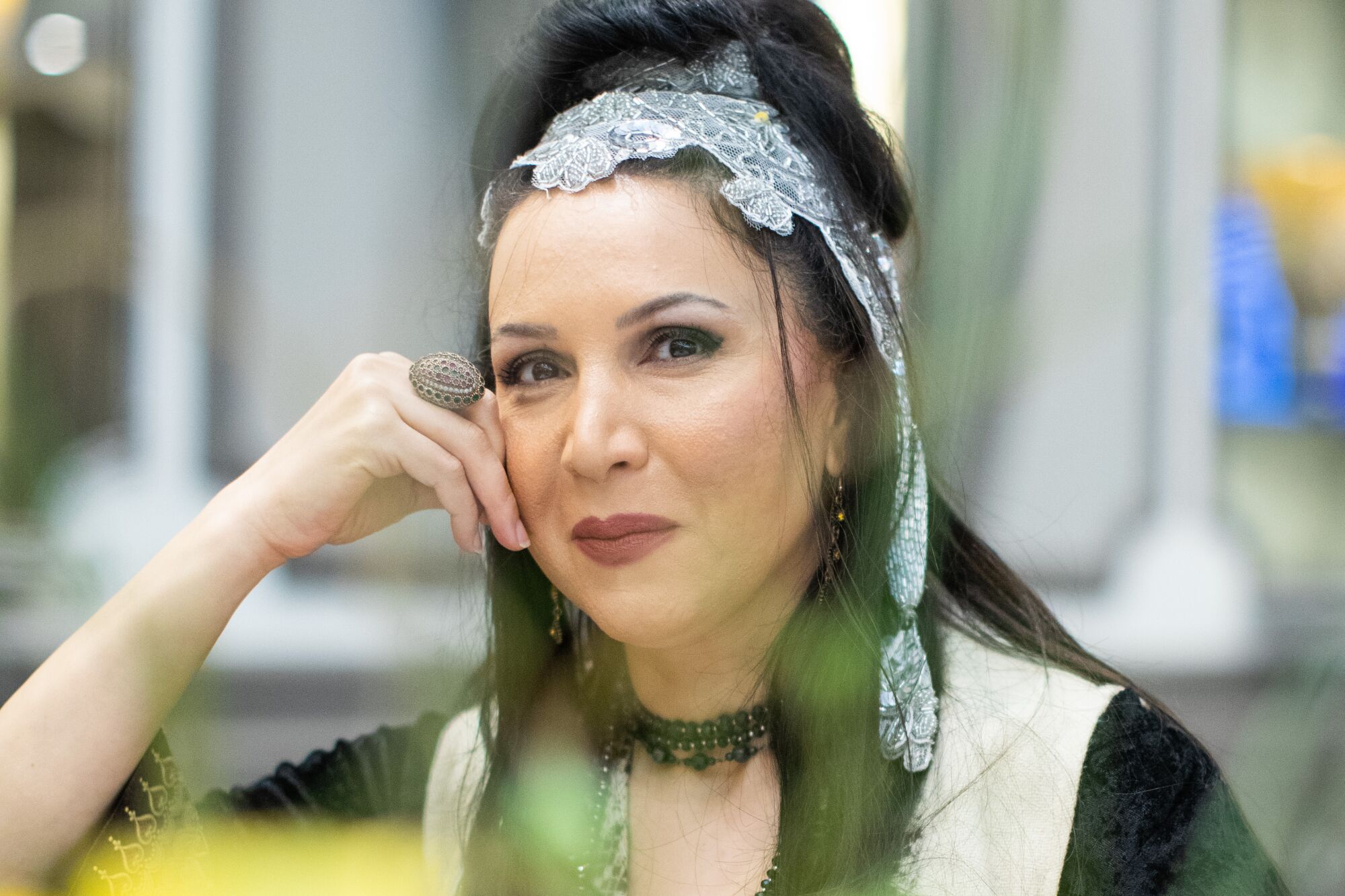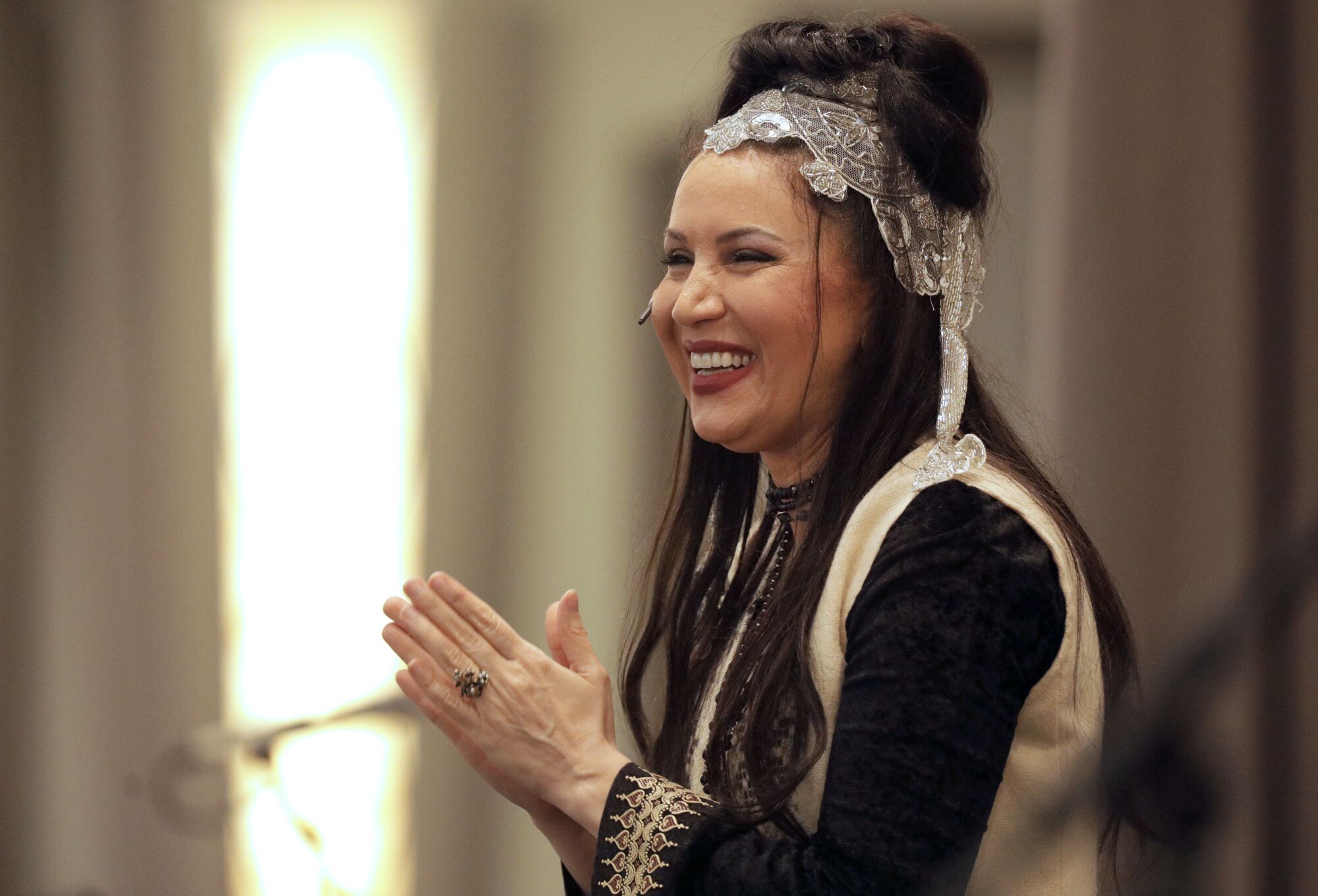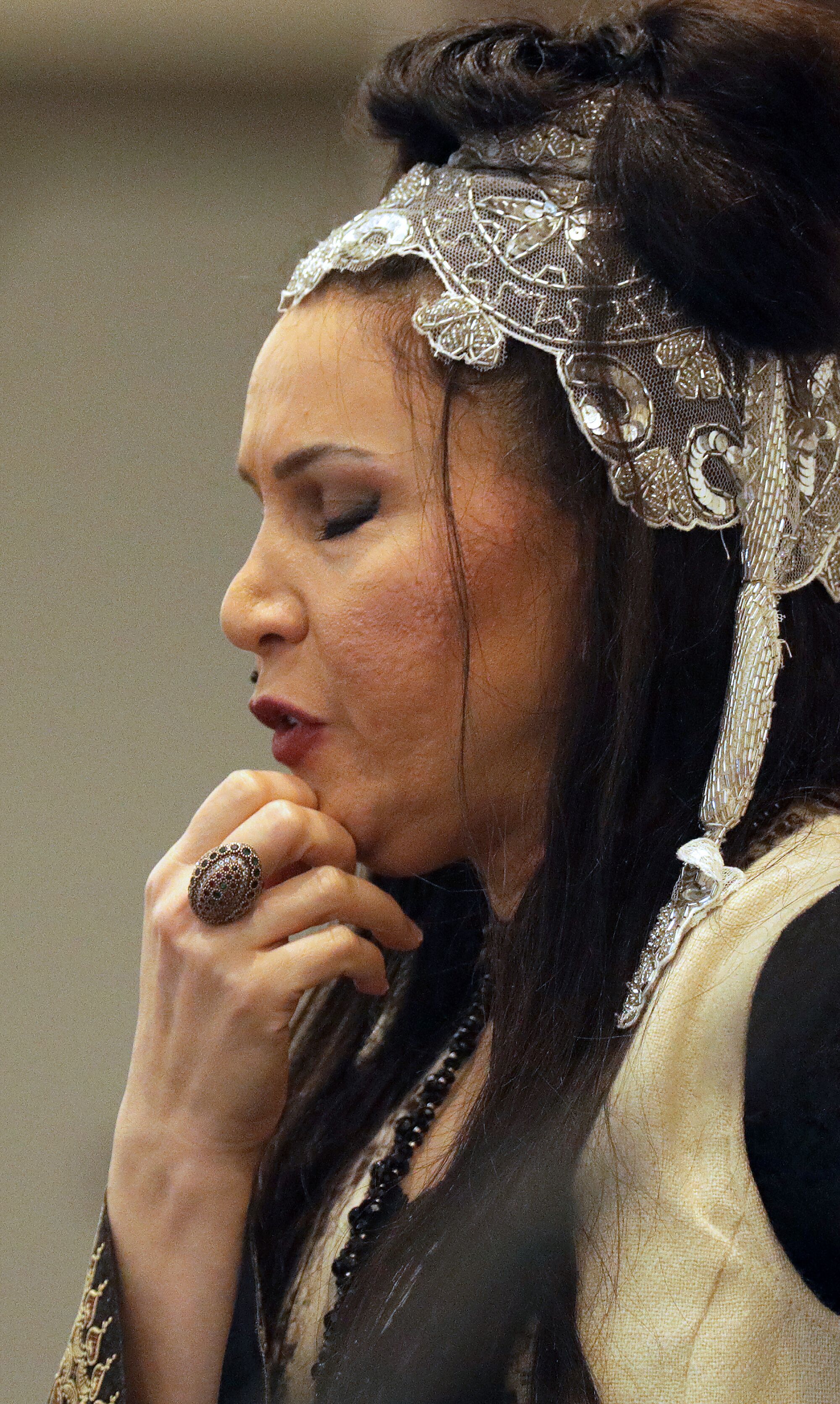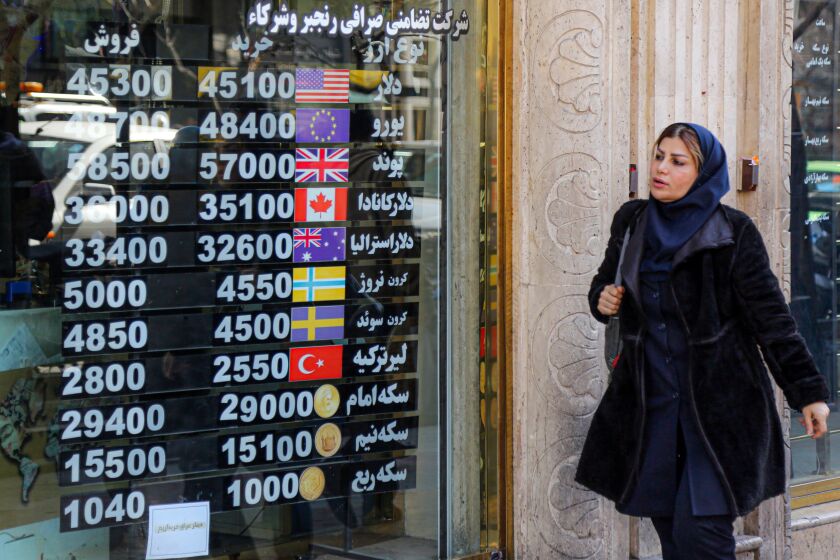Activists gather for Earth Day, urge action to avoid 'dystopian' future
Reuters
April 22, 2023

(Reuters) - Climate change campaigners gathered outside Britain's parliament building ahead of Earth Day to urge action on global warming, while volunteers worldwide geared up to plant trees and clear trash to mark the 54th annual celebration of the environment.
Earth Day this year, officially on Saturday, follows weeks of extreme weather with temperatures soaring to record highs in Thailand and a punishing heatwave in India, where at least 13 people died of heatstroke at a ceremony last weekend.
Average global temperatures could hit all-time highs in 2023 or 2024, climate scientists have warned.
"Climate impacts are here," Areeba Hamid, co-executive director of Greenpeace UK, said on Friday as climate change activists walked down the street outside parliament, some dressed in green costumes and green paint.
Hamid said when she now visits her hometown of Delhi, it feels like "putting your head in the oven" and that London's 2022 heatwave was like "a dystopian film".
"We can't afford that anymore."
Activists led by the Extinction Rebellion group have gathered in London to kick off a four-day action, billed "The Big One", to coincide with Earth Day.
About 30,000 people have signed up for family-friendly rallies and marches, marking a change in strategy for a group known for its disruptive tactics, including blocking roads, throwing paint and smashing windows.
Globally, there has been a flurry of activity in the run-up to Earth Day, with events being planned in Rome and Boston and major clean-up campaigns at Lake Dal in India's Srinagar and Florida's hurricane-hit Cape Coral.
In Peru, shamans on Friday made an offering to the "Pachamama", or Mother Earth. Holding yellow flowers and rattles, the shamans walked around a papier-mache globe as they performed a cleansing ritual.
The ancestral rituals - whose origins lie in the Indigenous cultures of Peru - are done to thank the Earth and build awareness of the planet, said Walter Alarcon, the president of the Healing Shamans of Peru International Organization.
Earlier in the week, U.S. President Joe Biden pledged to increase funding to help developing countries fight climate change and curb deforestation in Brazil's Amazon rainforest during a meeting with top world leaders.
Governments have fallen far short of pledges in the 2015 Paris Agreement to limit heating of the climate by shifting off fossil fuels, amid crises including COVID-19, Russia's invasion of Ukraine, food shortages and strained ties between China and the U.S., the top two greenhouse gas emitters.
A report by the U.N.'s Intergovernmental Panel on Climate Change (IPCC) says the planet is on track to warm beyond 1.5 degrees Celsius above pre-industrial times - a key threshold for even more damaging impacts - between 2030 and 2035.
"There is a rapidly closing window of opportunity to secure a liveable and sustainable future for all," the IPCC has said. "The choices and actions implemented in this decade will have impacts now and for thousands of years."
(Reporting by Reuters bureaus; Writing by Himani Sarkar; Editing by William Mallard)
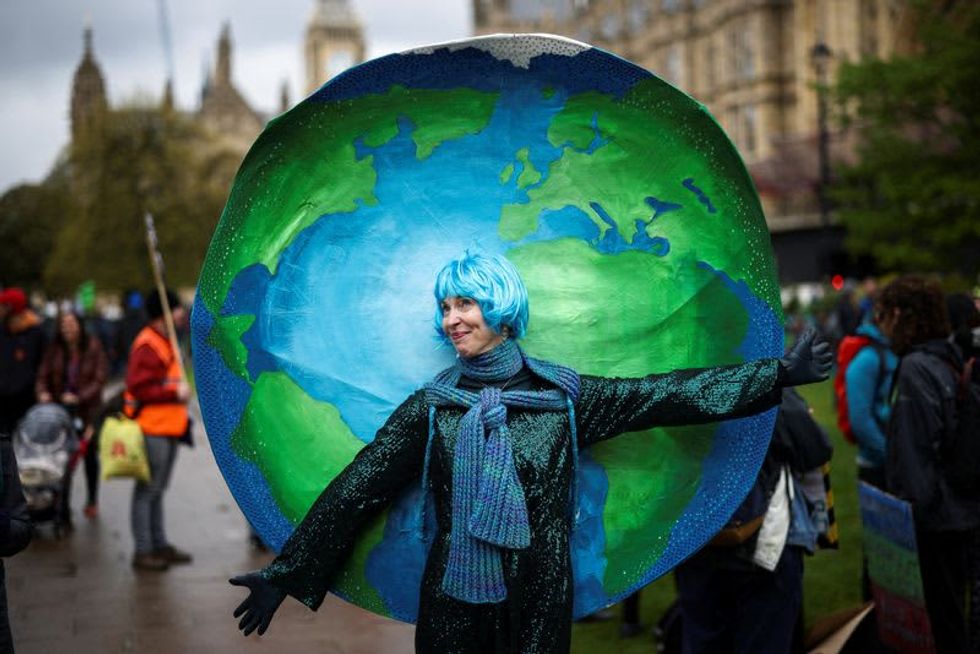


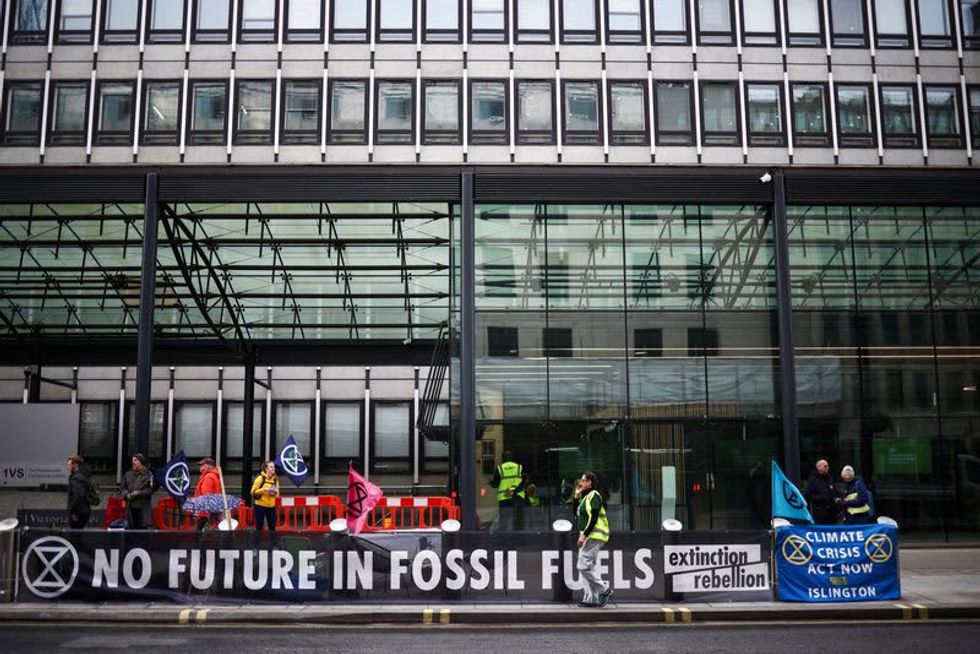
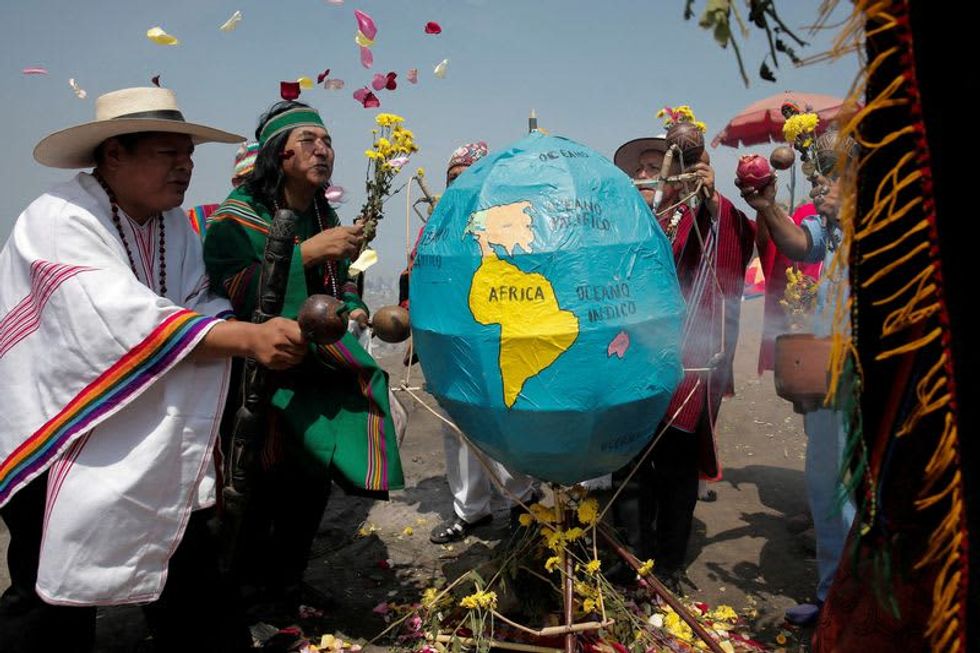

Reuters
April 22, 2023

(Reuters) - Climate change campaigners gathered outside Britain's parliament building ahead of Earth Day to urge action on global warming, while volunteers worldwide geared up to plant trees and clear trash to mark the 54th annual celebration of the environment.
Earth Day this year, officially on Saturday, follows weeks of extreme weather with temperatures soaring to record highs in Thailand and a punishing heatwave in India, where at least 13 people died of heatstroke at a ceremony last weekend.
Average global temperatures could hit all-time highs in 2023 or 2024, climate scientists have warned.
"Climate impacts are here," Areeba Hamid, co-executive director of Greenpeace UK, said on Friday as climate change activists walked down the street outside parliament, some dressed in green costumes and green paint.
Hamid said when she now visits her hometown of Delhi, it feels like "putting your head in the oven" and that London's 2022 heatwave was like "a dystopian film".
"We can't afford that anymore."
Activists led by the Extinction Rebellion group have gathered in London to kick off a four-day action, billed "The Big One", to coincide with Earth Day.
About 30,000 people have signed up for family-friendly rallies and marches, marking a change in strategy for a group known for its disruptive tactics, including blocking roads, throwing paint and smashing windows.
Globally, there has been a flurry of activity in the run-up to Earth Day, with events being planned in Rome and Boston and major clean-up campaigns at Lake Dal in India's Srinagar and Florida's hurricane-hit Cape Coral.
In Peru, shamans on Friday made an offering to the "Pachamama", or Mother Earth. Holding yellow flowers and rattles, the shamans walked around a papier-mache globe as they performed a cleansing ritual.
The ancestral rituals - whose origins lie in the Indigenous cultures of Peru - are done to thank the Earth and build awareness of the planet, said Walter Alarcon, the president of the Healing Shamans of Peru International Organization.
Earlier in the week, U.S. President Joe Biden pledged to increase funding to help developing countries fight climate change and curb deforestation in Brazil's Amazon rainforest during a meeting with top world leaders.
Governments have fallen far short of pledges in the 2015 Paris Agreement to limit heating of the climate by shifting off fossil fuels, amid crises including COVID-19, Russia's invasion of Ukraine, food shortages and strained ties between China and the U.S., the top two greenhouse gas emitters.
A report by the U.N.'s Intergovernmental Panel on Climate Change (IPCC) says the planet is on track to warm beyond 1.5 degrees Celsius above pre-industrial times - a key threshold for even more damaging impacts - between 2030 and 2035.
"There is a rapidly closing window of opportunity to secure a liveable and sustainable future for all," the IPCC has said. "The choices and actions implemented in this decade will have impacts now and for thousands of years."
(Reporting by Reuters bureaus; Writing by Himani Sarkar; Editing by William Mallard)






World Earth Day: Past 8 Years Hottest In Recorded History, 1 Million Species At Risk Of Extinction, Says UN
The World Earth Day is observed on April 22 every year. The first World Earth Day was observed in 1970 in the United States.

In Photos: The Climate Change Protests In LondonThe World Earth Day is observed on April 22 every year. The first World Earth Day was observed in 1970 in the United States.

Extreme climatic events, such as last year's Pakistan floods, have got more frequent lately. AP Photos
UPDATED: 22 APR 2023
The United Nations on the occasion of World Earth Day noted in a report that the past eight years have been the hottest in record history.
The UN also said that 1 million species are currently at the risk of extinction as climate change threatens biodiversity in the world.
The World Earth Day is observed every year on April 22. The day was marked by a report titled State of the Global Climate in 2022 by World Meteorological Organization (WMO), the UN agency for weather, climate, and water.
Among the other things, the WMO report says record greenhouse gas-levels are causing changes in every sphere of environment.
"WMO latest State of the Global Climate report shows that the last eight years were the eight warmest on record, and that sea level rise and ocean warming hit new highs. Record levels of greenhouse gases caused 'planetary scale changes on land, in the ocean and in the atmosphere'," said UN in a release.
Here we explain what the UN report says, what the World Earth Day is, and what the UN proposes to be done on climate change.
What is World Earth Day?
The World Earth Day is observed on April 22 every year. The first World Earth Day was observed in 1970 in the United States.
Senator Gaylord Nelson was a key figure in promoting the Earth Day at the time.
The Library of Congress notes, "Earth Day was first observed on April 22, 1970, when an estimated 20 million people nationwide attended the inaugural events at tens of thousands of sites including elementary and secondary schools, universities, and community sites across the United States. Senator Gaylord Nelson promoted Earth Day, calling upon students to fight for environmental causes and oppose environmental degradation with the same energy that they displayed in opposing the Vietnam War."
The objective of the World Earth Day is to promote environmental protectionism. It is currently observed in over 190 countries and witnesses participation of over 1 billion people.
The World Earth Day movement is credited with leading to an increase in funding to green efforts, increased environmental literacy, and coming up of environment-related laws.
"Earth Day 1970 led to the passage of landmark environmental laws in the United States, including the Clean Air, Clean Water and Endangered Species Acts and the establishment of the Environmental Protection Agency (EPA). Many countries soon adopted similar laws, and in 2016, the United Nations chose Earth Day as the day to sign the Paris Climate Agreement into force," notes EarthDay.Org, which coordinates the movement.
Past 8 years hottest ever: UN report
The WMO, the UN agency for weather, climate, and water, in its State of the Global Climate report said that the period of 2015-22 was the hottest since tracking began in 1850.
The WMO also reported that "massively scaled-up investments" for anti-climate change efforts are required, noted the UN release.
The UN release said, "The organization says its report, released ahead of this year’s Mother Earth Day, echoes UN Secretary-General António Guterres’ call for 'deeper, faster emissions cuts to limit global temperature rise to 1.5 degree Celsius', as well as 'massively scaled-up investments in adaptation and resilience, particularly for the most vulnerable countries and communities who have done the least to cause the crisis'," said the release.
WMO Secretary-General, Prof. Petteri Taalas also listed the recent climate disasters that highlight the gravity of climate change crisis. He said that
"populations worldwide continue to be gravely impacted by extreme weather and climate events" and stressed that last year, "continuous drought in East Africa, record breaking rainfall in Pakistan and record-breaking heatwaves in China and Europe affected tens of millions, drove food insecurity, boosted mass migration, and cost billions of dollars in loss and damage".
The report further noted that "Antarctic sea ice fell to its lowest extent on record and the melting of some European glaciers was, literally, off the charts".
On World Earth Day, UN Secretary-General António Guterres also spoke of the threat to biodiversity.
"In his message on Earth Day, UN chief Mr. Guterres warned that 'biodiversity is collapsing as one million species teeter on the brink of extinction', and called on the world to end its 'relentless and senseless wars on nature', insisting that 'we have the tools, the knowledge, and the solutions' to address climate change," said the UN release.
The United Nations on the occasion of World Earth Day noted in a report that the past eight years have been the hottest in record history.
The UN also said that 1 million species are currently at the risk of extinction as climate change threatens biodiversity in the world.
The World Earth Day is observed every year on April 22. The day was marked by a report titled State of the Global Climate in 2022 by World Meteorological Organization (WMO), the UN agency for weather, climate, and water.
Among the other things, the WMO report says record greenhouse gas-levels are causing changes in every sphere of environment.
"WMO latest State of the Global Climate report shows that the last eight years were the eight warmest on record, and that sea level rise and ocean warming hit new highs. Record levels of greenhouse gases caused 'planetary scale changes on land, in the ocean and in the atmosphere'," said UN in a release.
Here we explain what the UN report says, what the World Earth Day is, and what the UN proposes to be done on climate change.
What is World Earth Day?
The World Earth Day is observed on April 22 every year. The first World Earth Day was observed in 1970 in the United States.
Senator Gaylord Nelson was a key figure in promoting the Earth Day at the time.
The Library of Congress notes, "Earth Day was first observed on April 22, 1970, when an estimated 20 million people nationwide attended the inaugural events at tens of thousands of sites including elementary and secondary schools, universities, and community sites across the United States. Senator Gaylord Nelson promoted Earth Day, calling upon students to fight for environmental causes and oppose environmental degradation with the same energy that they displayed in opposing the Vietnam War."
The objective of the World Earth Day is to promote environmental protectionism. It is currently observed in over 190 countries and witnesses participation of over 1 billion people.
The World Earth Day movement is credited with leading to an increase in funding to green efforts, increased environmental literacy, and coming up of environment-related laws.
"Earth Day 1970 led to the passage of landmark environmental laws in the United States, including the Clean Air, Clean Water and Endangered Species Acts and the establishment of the Environmental Protection Agency (EPA). Many countries soon adopted similar laws, and in 2016, the United Nations chose Earth Day as the day to sign the Paris Climate Agreement into force," notes EarthDay.Org, which coordinates the movement.
Past 8 years hottest ever: UN report
The WMO, the UN agency for weather, climate, and water, in its State of the Global Climate report said that the period of 2015-22 was the hottest since tracking began in 1850.
The WMO also reported that "massively scaled-up investments" for anti-climate change efforts are required, noted the UN release.
The UN release said, "The organization says its report, released ahead of this year’s Mother Earth Day, echoes UN Secretary-General António Guterres’ call for 'deeper, faster emissions cuts to limit global temperature rise to 1.5 degree Celsius', as well as 'massively scaled-up investments in adaptation and resilience, particularly for the most vulnerable countries and communities who have done the least to cause the crisis'," said the release.
"populations worldwide continue to be gravely impacted by extreme weather and climate events" and stressed that last year, "continuous drought in East Africa, record breaking rainfall in Pakistan and record-breaking heatwaves in China and Europe affected tens of millions, drove food insecurity, boosted mass migration, and cost billions of dollars in loss and damage".
The report further noted that "Antarctic sea ice fell to its lowest extent on record and the melting of some European glaciers was, literally, off the charts".
On World Earth Day, UN Secretary-General António Guterres also spoke of the threat to biodiversity.
"In his message on Earth Day, UN chief Mr. Guterres warned that 'biodiversity is collapsing as one million species teeter on the brink of extinction', and called on the world to end its 'relentless and senseless wars on nature', insisting that 'we have the tools, the knowledge, and the solutions' to address climate change," said the UN release.
Activists and organisations dedicated to combating climate change, such as Extinction Rebellion and Red Rebel Brigade, held a protest in London in front of the Parliament to call for tougher measures to address climate change. The protesters called for a stop on the usage of fossil fuels. Some wore masks depicting Prime Minister Rishi Sunak and ministers Michael Gove and Jeremy Hunt.
UPDATED: 22 APR 2023

Members of the Red Rebel Brigade join Extinction Rebellion demonstrators in Westminster, London, on day one of the environmental action group's four days of action that they have called "The Big One".

Activists protest outside the Houses of Parliament in London. Extinction Rebellion and other environmental groups are protesting for four days from Friday to Monday, with an event they are calling "The Big One".

Activists wearing masks depicting Prime Minister Rishi Sunak, right, Michael Gove and Chancellor Jeremy Hunt as they protest outside the Houses of Parliament in London.





Activists wearing masks depicting Prime Minister Rishi Sunak and Chancellor Jeremy Hunt as they protest outside the Houses of Parliament in London.
Climate Protest | Photos: AP/Kin Cheung
4 Tips To Drive Action On Climate Change From Huge New Global Risk Study. Earth Day
Joan Michelson
Contributor
Apr 22, 2023

Activists from climate group Fridays for Future shout slogans and march during a Global

Nuclear hazard signs are seen in the village of Kopachi on January 29, 2006
Because we all think of “risk” and “safety” and “resilience” differently, Lloyd’s and Gallup chose to let the respondent’s perceptions prevail, and put their responses into the context of their lives. “We'll record the sex of the respondent, their income, their educational status, where they live, whether it's rural or urban. And so, we can start to look at the data in a really granular fashion to understand what are the factors that are driving, for example, whether people think about risk as opportunity, or harm.”
They also drilled down to explore the respondents’ daily lives. “One of the most ambitious questions that we ask in the poll,” Cumbers said, “is ‘what's the greatest source of risk to your safety in your daily life?’ And so, you can see that with the framing there, you introduce the concept of risk and it being about, you know, risk to safety and in daily life. But then you let the respondent interpret that in their own context and, and give their response.”
“One of the great things about this data set, that it can be used in a very granular fashion, by all kinds of agencies, you know, civil society, policy makers, academics, et cetera, governments,” Cumbers added, so they sought to gather data that could be used at all levels.

Screenshot - Lloyd's Register risk poll, climate & education & personal experience chart.
Here are four key findings related to climate change (you can find the full summary here):
· Women are more concerned about climate change in high-income countries: “We need to look at those granular differences at the country level, and particularly actually when it comes to climate change, it's country income that has an impact,” Cumbers explained, “So, women tend to be more worried about it than men in high income countries, but in low income countries it's the reverse.” These findings align with a recent study on the U.S. from the Yale Center for Climate Communications that women in the U.S. are more likely than men – 59% to 52% – “to be either Alarmed or Concerned about global warming.”
· People who have experienced natural disasters are more likely to view climate change as a “very or serious threat”: “Research shows that experience of severe weather is a driver of people's concern about climate change,” Cumbers explained. “So, people are more likely to understand, particularly if they don't have high levels of education, the concept of severe weather, because it's something tangible to them, it's something they've experienced, whereas climate change is quite an abstract construct.”

· Communication around climate change needs to be personal – and simplified: Building on the point that personal experiences with natural disasters increases climate change awareness, Cumbers emphasized keeping it personal. She said, “that gives climate change communicators a really important tool to be able to connect with people around the world, regardless of their income status, regardless of their level of education, to actually tap into people's increasing experience with severe weather and to make that link then with the changing climate. And then you can start to build action strategies on top of that In terms of building resilience, in terms of early warning, early action.”
Their research also found that communication needs to be simplified to get across, adding that, “Learning around climate change, communication and using clear and simple language.”
· Take “a granular approach to resilience”: “If you look at resilience, the key learning really is about taking a granular approach to resilience,” Cumbers reflected. “Unless you really understand the context of community that you are wanting to support, you are going to fail to have an impact and build resilience.”

Screenshot - Lloyd's Register Resilience Index lrfoundation.org.uk
They also developed the Resilience Index, which their brochure describes as: “an exploratory approach towards creating an indicator of how well-equipped people are to handle adversity based on their personal circumstances and perceptions of support.”
Focused on taking action
The researchers’ hope, Cumbers summarized, is that their data is used to make an impact, to improve people’s lives.
“We want data that that is actually going to drive impact. So, we always ask, ‘and what would you do with it? And what consequence would it have and how would it change things? And how would it actually make the world safer on the ground? What's the impact on people going to be?’ “
To that end, they invited proposals for “turning the World Risk Poll into action.”
Listen to the full interview with Dr. Sarah Cumbers on Electric Ladies Podcast here.
Follow me on Twitter or LinkedIn. Check out my website.
Joan Michelson is an ESG consultant, host of the acclaimed Electric Ladies Podcast, dynamic public speaker and career advisor.
Joan Michelson
Contributor
Apr 22, 2023

Activists from climate group Fridays for Future shout slogans and march during a Global
AFP VIA GETTY IMAGES
Do you feel safe? How do you perceive risk? Do you feel at risk from climate change? These are some of the questions that a massive new global study by the Lloyd’s Register Foundation and Gallup surveyed 120,000 people across 121 countries to find out. This Earth Day, their findings on perceptions of risk from climate change are especially salient.
Using local teams and survey techniques to ascertain authentic answers, Lloyd’s and Gallup found a wide range of fascinating information about how safe people really feel across the globe, and why.
In this study, called “A Resilient World?,” they explored how safe people feel in their homes, communities, countries and in society at large, sometimes employing strategies such as questioning men and women in separate rooms at the same time to enable women to speak freely and confidentially.

Sarah Cumbers, Ph.D., Lloyd's Register Foundation
Do you feel safe? How do you perceive risk? Do you feel at risk from climate change? These are some of the questions that a massive new global study by the Lloyd’s Register Foundation and Gallup surveyed 120,000 people across 121 countries to find out. This Earth Day, their findings on perceptions of risk from climate change are especially salient.
Using local teams and survey techniques to ascertain authentic answers, Lloyd’s and Gallup found a wide range of fascinating information about how safe people really feel across the globe, and why.
In this study, called “A Resilient World?,” they explored how safe people feel in their homes, communities, countries and in society at large, sometimes employing strategies such as questioning men and women in separate rooms at the same time to enable women to speak freely and confidentially.

Sarah Cumbers, Ph.D., Lloyd's Register Foundation
SARAH CUMBERS, PH.D.
In an exclusive, in-depth interview about the World Risk Poll’s findings on Electric Ladies Podcast recently, Dr. Sarah Cumbers, Director of Evidence and Insight at Lloyd's Register Foundation who led the survey, explained that they could ascertain some sense of the how the interviewees are perceiving “risk” and “safety” based on the contexts of their lives. “The 2019 poll included a question about the meaning of the word risk. And we know that people around the world interpret that word differently and to some risk is about opportunity and for some it's about harm…it will just depend on the context, ” Cumbers said.
“We're (Lloyd’s Register Foundation) a global safety charity. We've got a mission to make the world a safer place, and we invest in research and education and, and innovation programs around the world that impact on the safety of life and property,” Cumbers said. “And that's why we commissioned this poll, because we wanted to understand how people around the world think about their risk and safety and how they experience different risks.”
Clarifying “risk”
In an exclusive, in-depth interview about the World Risk Poll’s findings on Electric Ladies Podcast recently, Dr. Sarah Cumbers, Director of Evidence and Insight at Lloyd's Register Foundation who led the survey, explained that they could ascertain some sense of the how the interviewees are perceiving “risk” and “safety” based on the contexts of their lives. “The 2019 poll included a question about the meaning of the word risk. And we know that people around the world interpret that word differently and to some risk is about opportunity and for some it's about harm…it will just depend on the context, ” Cumbers said.
“We're (Lloyd’s Register Foundation) a global safety charity. We've got a mission to make the world a safer place, and we invest in research and education and, and innovation programs around the world that impact on the safety of life and property,” Cumbers said. “And that's why we commissioned this poll, because we wanted to understand how people around the world think about their risk and safety and how they experience different risks.”
Clarifying “risk”

Nuclear hazard signs are seen in the village of Kopachi on January 29, 2006
Because we all think of “risk” and “safety” and “resilience” differently, Lloyd’s and Gallup chose to let the respondent’s perceptions prevail, and put their responses into the context of their lives. “We'll record the sex of the respondent, their income, their educational status, where they live, whether it's rural or urban. And so, we can start to look at the data in a really granular fashion to understand what are the factors that are driving, for example, whether people think about risk as opportunity, or harm.”
They also drilled down to explore the respondents’ daily lives. “One of the most ambitious questions that we ask in the poll,” Cumbers said, “is ‘what's the greatest source of risk to your safety in your daily life?’ And so, you can see that with the framing there, you introduce the concept of risk and it being about, you know, risk to safety and in daily life. But then you let the respondent interpret that in their own context and, and give their response.”
“One of the great things about this data set, that it can be used in a very granular fashion, by all kinds of agencies, you know, civil society, policy makers, academics, et cetera, governments,” Cumbers added, so they sought to gather data that could be used at all levels.

Screenshot - Lloyd's Register risk poll, climate & education & personal experience chart.
Here are four key findings related to climate change (you can find the full summary here):
· Women are more concerned about climate change in high-income countries: “We need to look at those granular differences at the country level, and particularly actually when it comes to climate change, it's country income that has an impact,” Cumbers explained, “So, women tend to be more worried about it than men in high income countries, but in low income countries it's the reverse.” These findings align with a recent study on the U.S. from the Yale Center for Climate Communications that women in the U.S. are more likely than men – 59% to 52% – “to be either Alarmed or Concerned about global warming.”
· People who have experienced natural disasters are more likely to view climate change as a “very or serious threat”: “Research shows that experience of severe weather is a driver of people's concern about climate change,” Cumbers explained. “So, people are more likely to understand, particularly if they don't have high levels of education, the concept of severe weather, because it's something tangible to them, it's something they've experienced, whereas climate change is quite an abstract construct.”

· Communication around climate change needs to be personal – and simplified: Building on the point that personal experiences with natural disasters increases climate change awareness, Cumbers emphasized keeping it personal. She said, “that gives climate change communicators a really important tool to be able to connect with people around the world, regardless of their income status, regardless of their level of education, to actually tap into people's increasing experience with severe weather and to make that link then with the changing climate. And then you can start to build action strategies on top of that In terms of building resilience, in terms of early warning, early action.”
Their research also found that communication needs to be simplified to get across, adding that, “Learning around climate change, communication and using clear and simple language.”
· Take “a granular approach to resilience”: “If you look at resilience, the key learning really is about taking a granular approach to resilience,” Cumbers reflected. “Unless you really understand the context of community that you are wanting to support, you are going to fail to have an impact and build resilience.”

Screenshot - Lloyd's Register Resilience Index lrfoundation.org.uk
They also developed the Resilience Index, which their brochure describes as: “an exploratory approach towards creating an indicator of how well-equipped people are to handle adversity based on their personal circumstances and perceptions of support.”
Focused on taking action
The researchers’ hope, Cumbers summarized, is that their data is used to make an impact, to improve people’s lives.
“We want data that that is actually going to drive impact. So, we always ask, ‘and what would you do with it? And what consequence would it have and how would it change things? And how would it actually make the world safer on the ground? What's the impact on people going to be?’ “
To that end, they invited proposals for “turning the World Risk Poll into action.”
Listen to the full interview with Dr. Sarah Cumbers on Electric Ladies Podcast here.
Follow me on Twitter or LinkedIn. Check out my website.
Joan Michelson is an ESG consultant, host of the acclaimed Electric Ladies Podcast, dynamic public speaker and career advisor.
Earth Day 2023 and our fatal affinity for fossil fuels
Lauren Boebert says liberals want Earth Day to be about climate change 'to divide us'
David McAfee
April 22, 2023

Congresswoman Lauren Boebert speaks during CPAC Texas 2022 conference at Hilton Anatole. (Shutterstock.com)
U.S. Rep. Lauren Boebert (R) celebrated Earth Day Saturday by attacking climate change and calling out liberals for trying "to divide us."
Boebert, who warned last year against hosting drag queen "storytime" events in her Colorado district only to see them do it anyway and achieve enormous success, made exactly one tweet about Earth Day. At the end of the day, Boebert posted on Twitter that we should celebrate the day by remembering "to appreciate this incredible world God has given us."
She further insisted that liberals are trying to change the purpose of the holiday.
"Liberals will try to make this day about climate change to divide us," the congresswoman wrote. "Let’s focus on being appreciative, good stewards of what God has given us instead."
Contrary to Boebert's message, the origins of Earth Day are secular. According to National Geographic, Earth Day was first celebrated in 1970 by a US Senator from Wisconsin sought to raise awareness about environmental issues like climate change.
David McAfee
April 22, 2023

Congresswoman Lauren Boebert speaks during CPAC Texas 2022 conference at Hilton Anatole. (Shutterstock.com)
U.S. Rep. Lauren Boebert (R) celebrated Earth Day Saturday by attacking climate change and calling out liberals for trying "to divide us."
Boebert, who warned last year against hosting drag queen "storytime" events in her Colorado district only to see them do it anyway and achieve enormous success, made exactly one tweet about Earth Day. At the end of the day, Boebert posted on Twitter that we should celebrate the day by remembering "to appreciate this incredible world God has given us."
She further insisted that liberals are trying to change the purpose of the holiday.
"Liberals will try to make this day about climate change to divide us," the congresswoman wrote. "Let’s focus on being appreciative, good stewards of what God has given us instead."
Contrary to Boebert's message, the origins of Earth Day are secular. According to National Geographic, Earth Day was first celebrated in 1970 by a US Senator from Wisconsin sought to raise awareness about environmental issues like climate change.






